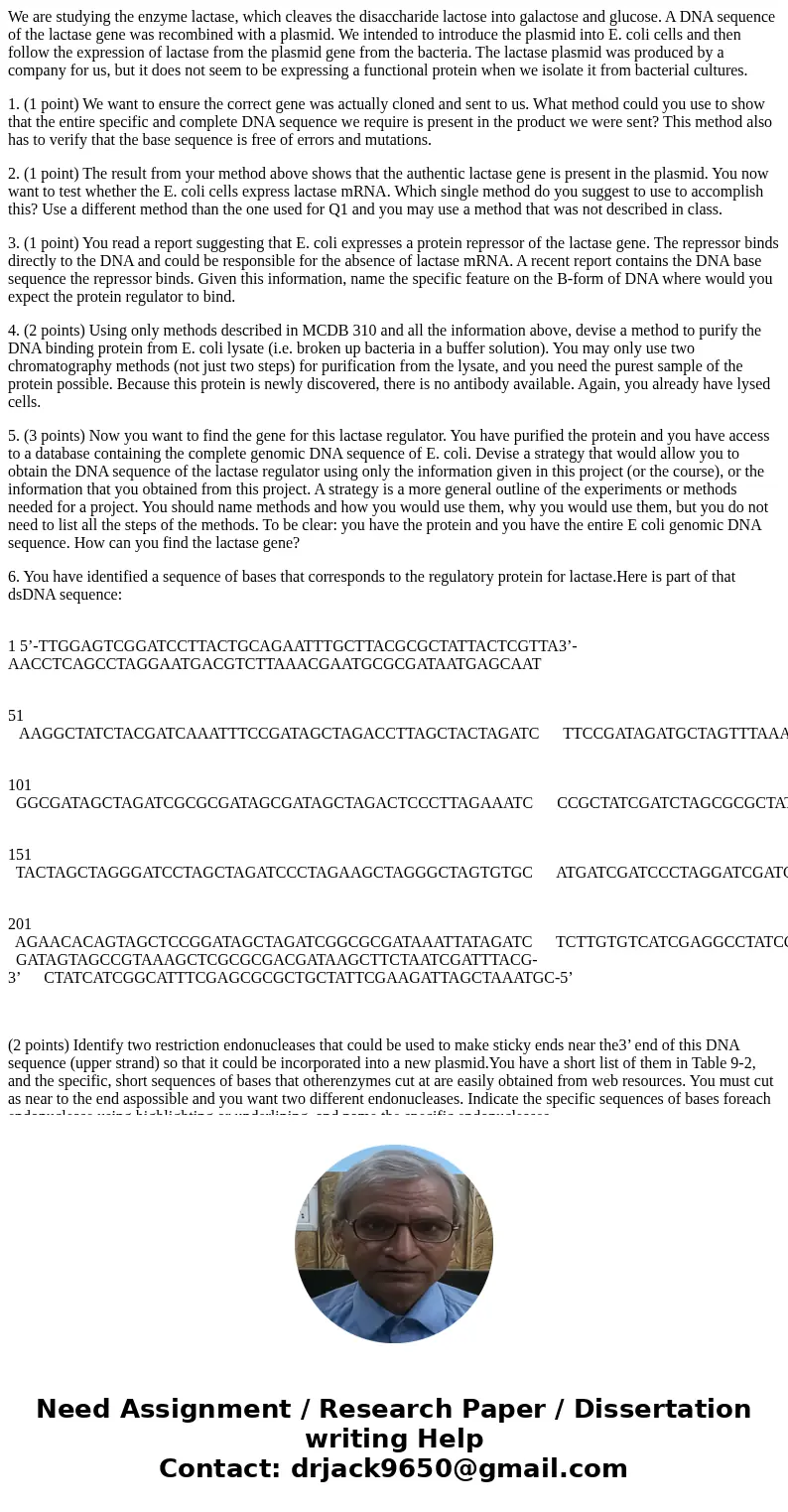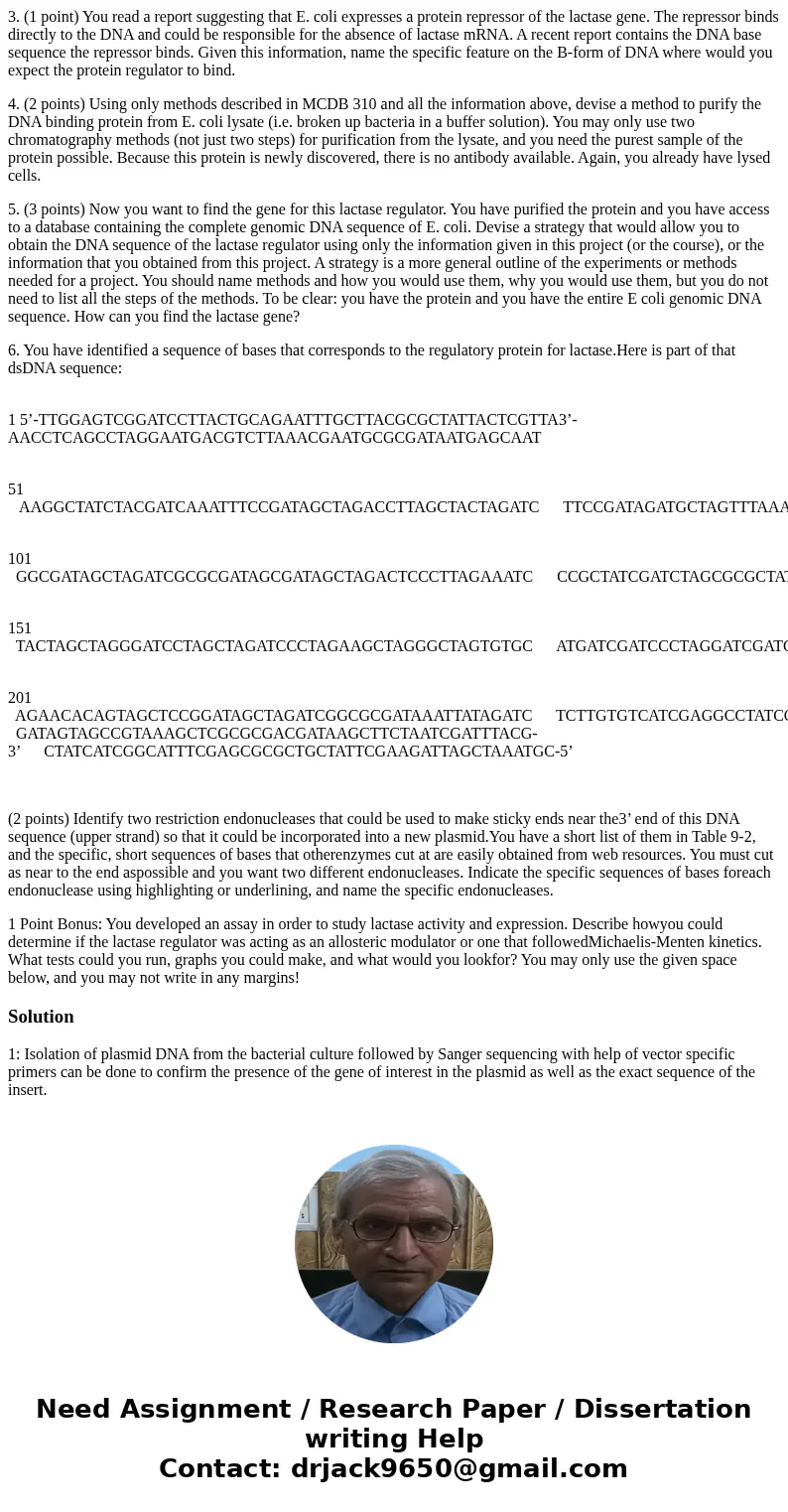We are studying the enzyme lactase which cleaves the disacch
We are studying the enzyme lactase, which cleaves the disaccharide lactose into galactose and glucose. A DNA sequence of the lactase gene was recombined with a plasmid. We intended to introduce the plasmid into E. coli cells and then follow the expression of lactase from the plasmid gene from the bacteria. The lactase plasmid was produced by a company for us, but it does not seem to be expressing a functional protein when we isolate it from bacterial cultures.
1. (1 point) We want to ensure the correct gene was actually cloned and sent to us. What method could you use to show that the entire specific and complete DNA sequence we require is present in the product we were sent? This method also has to verify that the base sequence is free of errors and mutations.
2. (1 point) The result from your method above shows that the authentic lactase gene is present in the plasmid. You now want to test whether the E. coli cells express lactase mRNA. Which single method do you suggest to use to accomplish this? Use a different method than the one used for Q1 and you may use a method that was not described in class.
3. (1 point) You read a report suggesting that E. coli expresses a protein repressor of the lactase gene. The repressor binds directly to the DNA and could be responsible for the absence of lactase mRNA. A recent report contains the DNA base sequence the repressor binds. Given this information, name the specific feature on the B-form of DNA where would you expect the protein regulator to bind.
4. (2 points) Using only methods described in MCDB 310 and all the information above, devise a method to purify the DNA binding protein from E. coli lysate (i.e. broken up bacteria in a buffer solution). You may only use two chromatography methods (not just two steps) for purification from the lysate, and you need the purest sample of the protein possible. Because this protein is newly discovered, there is no antibody available. Again, you already have lysed cells.
5. (3 points) Now you want to find the gene for this lactase regulator. You have purified the protein and you have access to a database containing the complete genomic DNA sequence of E. coli. Devise a strategy that would allow you to obtain the DNA sequence of the lactase regulator using only the information given in this project (or the course), or the information that you obtained from this project. A strategy is a more general outline of the experiments or methods needed for a project. You should name methods and how you would use them, why you would use them, but you do not need to list all the steps of the methods. To be clear: you have the protein and you have the entire E coli genomic DNA sequence. How can you find the lactase gene?
6. You have identified a sequence of bases that corresponds to the regulatory protein for lactase.Here is part of that dsDNA sequence:
1 5’-TTGGAGTCGGATCCTTACTGCAGAATTTGCTTACGCGCTATTACTCGTTA3’-AACCTCAGCCTAGGAATGACGTCTTAAACGAATGCGCGATAATGAGCAAT
51 AAGGCTATCTACGATCAAATTTCCGATAGCTAGACCTTAGCTACTAGATC TTCCGATAGATGCTAGTTTAAAGGCTATCGATCTGGAATCGATGATCTAG
101 GGCGATAGCTAGATCGCGCGATAGCGATAGCTAGACTCCCTTAGAAATC CCGCTATCGATCTAGCGCGCTATCGCTATCGATCTGAGGGAATCTTTAG
151 TACTAGCTAGGGATCCTAGCTAGATCCCTAGAAGCTAGGGCTAGTGTGC ATGATCGATCCCTAGGATCGATCTAGGGATCTTCGATCCCGATCACACG
201 AGAACACAGTAGCTCCGGATAGCTAGATCGGCGCGATAAATTATAGATC TCTTGTGTCATCGAGGCCTATCGATCTAGCCGCGCTATTTAATATCTAC251 GATAGTAGCCGTAAAGCTCGCGCGACGATAAGCTTCTAATCGATTTACG-3’ CTATCATCGGCATTTCGAGCGCGCTGCTATTCGAAGATTAGCTAAATGC-5’
(2 points) Identify two restriction endonucleases that could be used to make sticky ends near the3’ end of this DNA sequence (upper strand) so that it could be incorporated into a new plasmid.You have a short list of them in Table 9-2, and the specific, short sequences of bases that otherenzymes cut at are easily obtained from web resources. You must cut as near to the end aspossible and you want two different endonucleases. Indicate the specific sequences of bases foreach endonuclease using highlighting or underlining, and name the specific endonucleases.
1 Point Bonus: You developed an assay in order to study lactase activity and expression. Describe howyou could determine if the lactase regulator was acting as an allosteric modulator or one that followedMichaelis-Menten kinetics. What tests could you run, graphs you could make, and what would you lookfor? You may only use the given space below, and you may not write in any margins!
Solution
1: Isolation of plasmid DNA from the bacterial culture followed by Sanger sequencing with help of vector specific primers can be done to confirm the presence of the gene of interest in the plasmid as well as the exact sequence of the insert.


 Homework Sourse
Homework Sourse